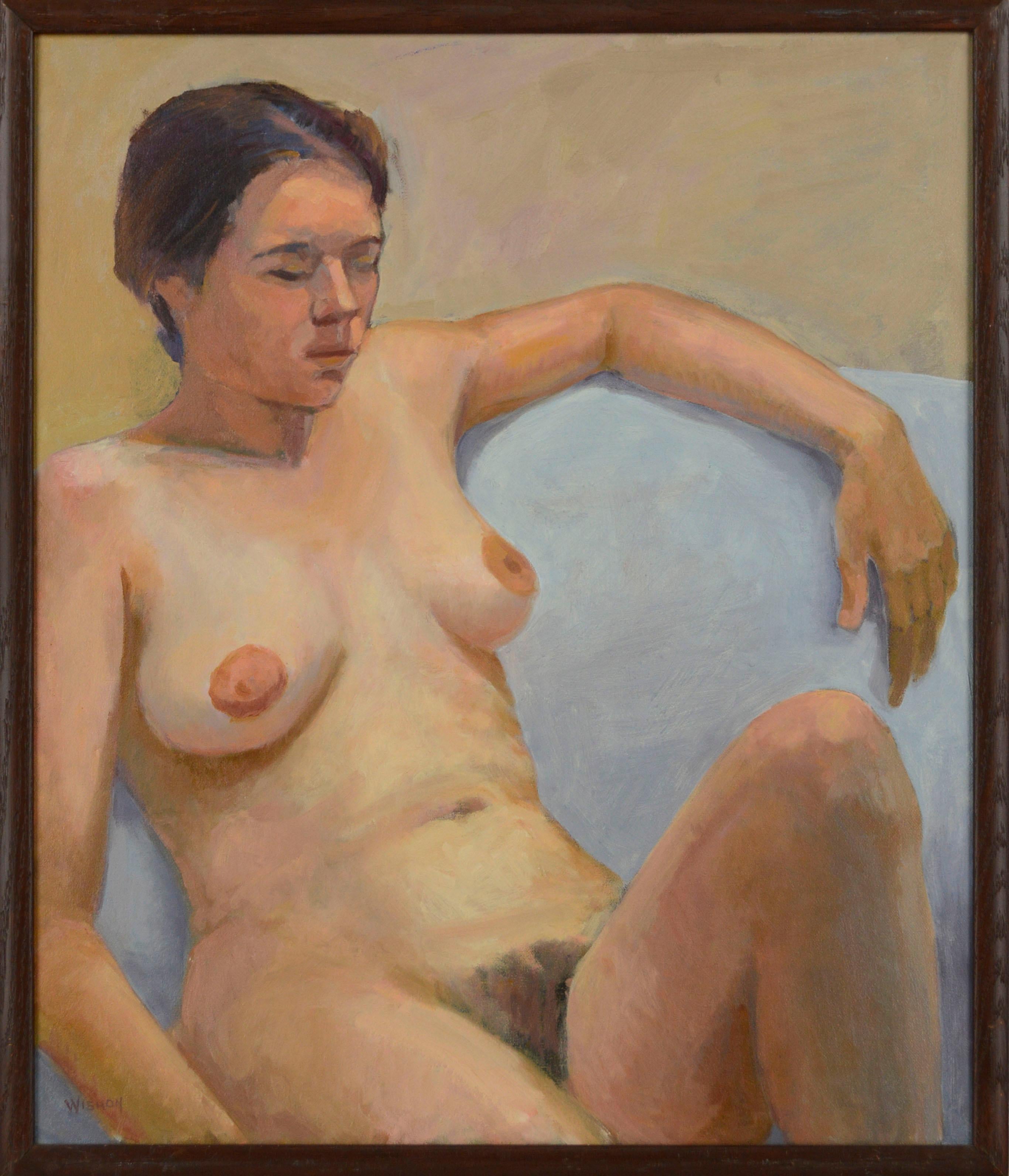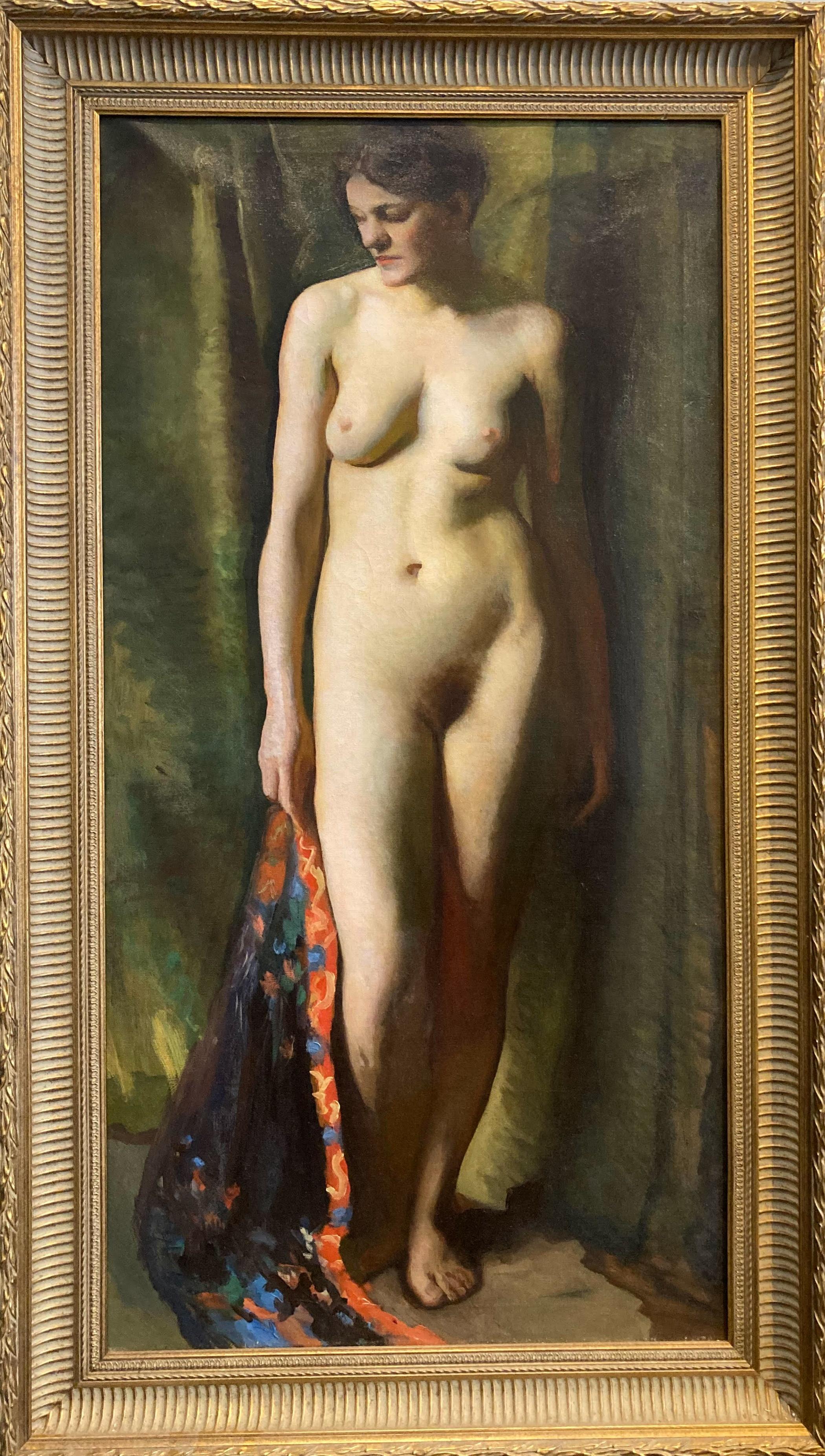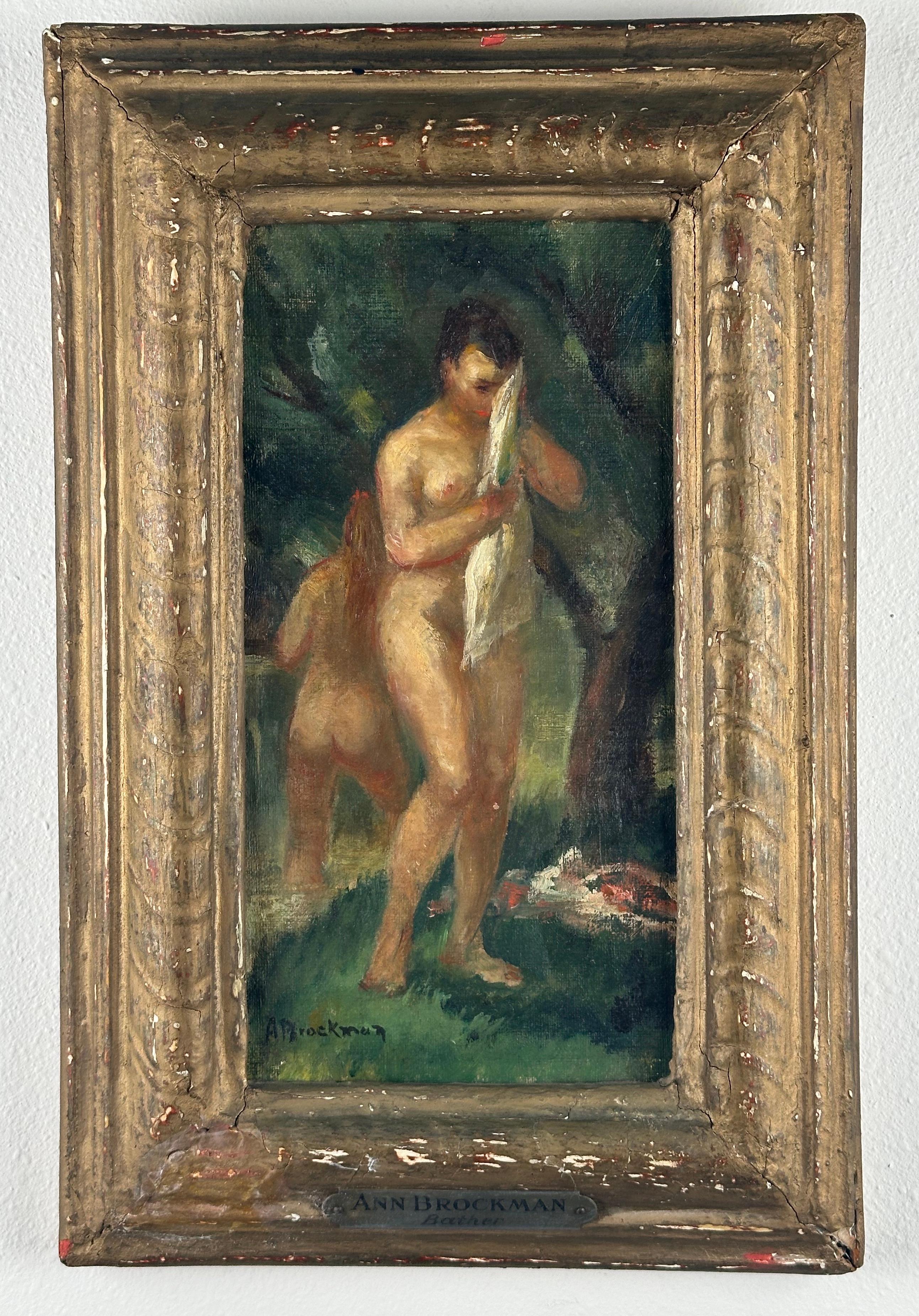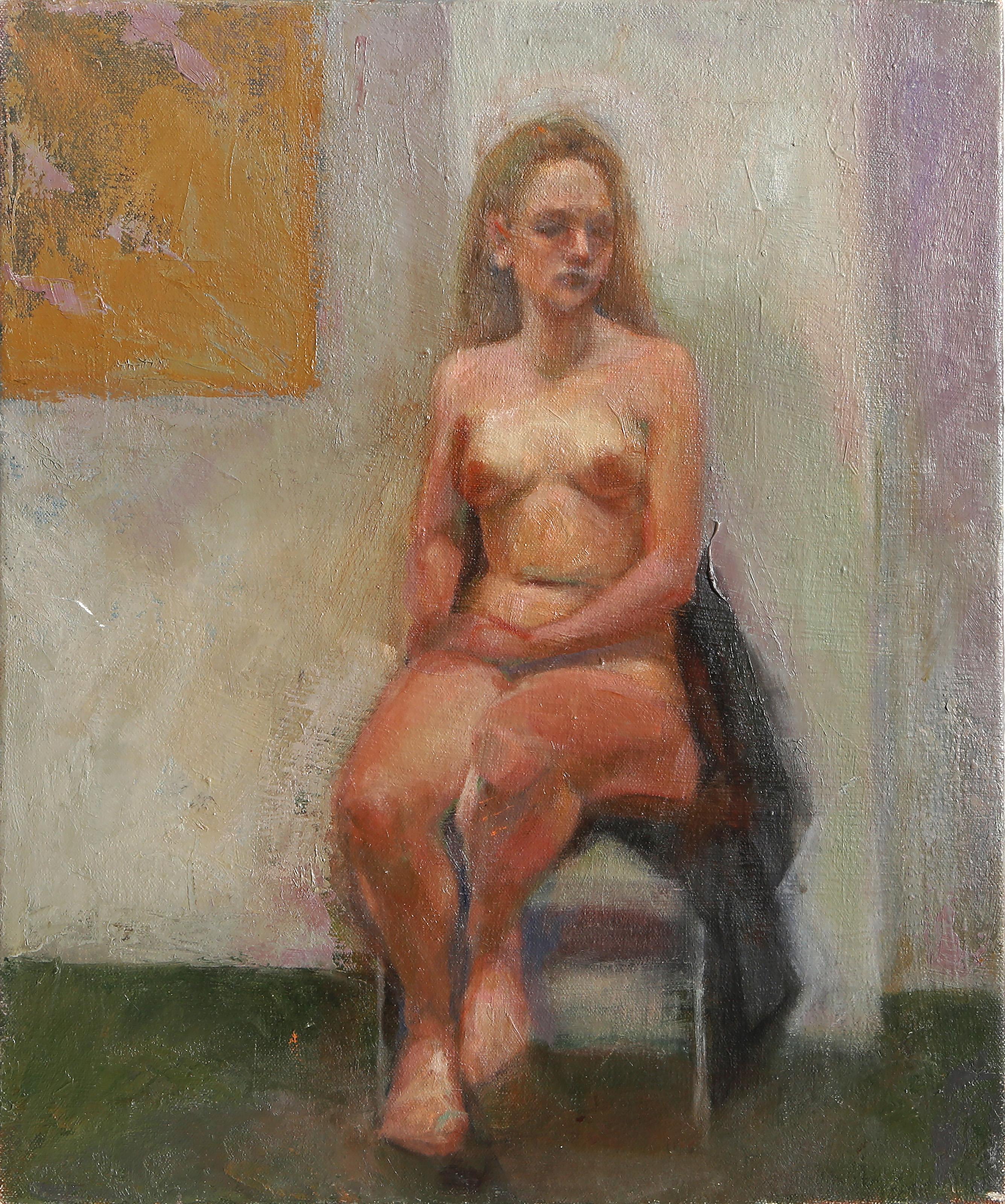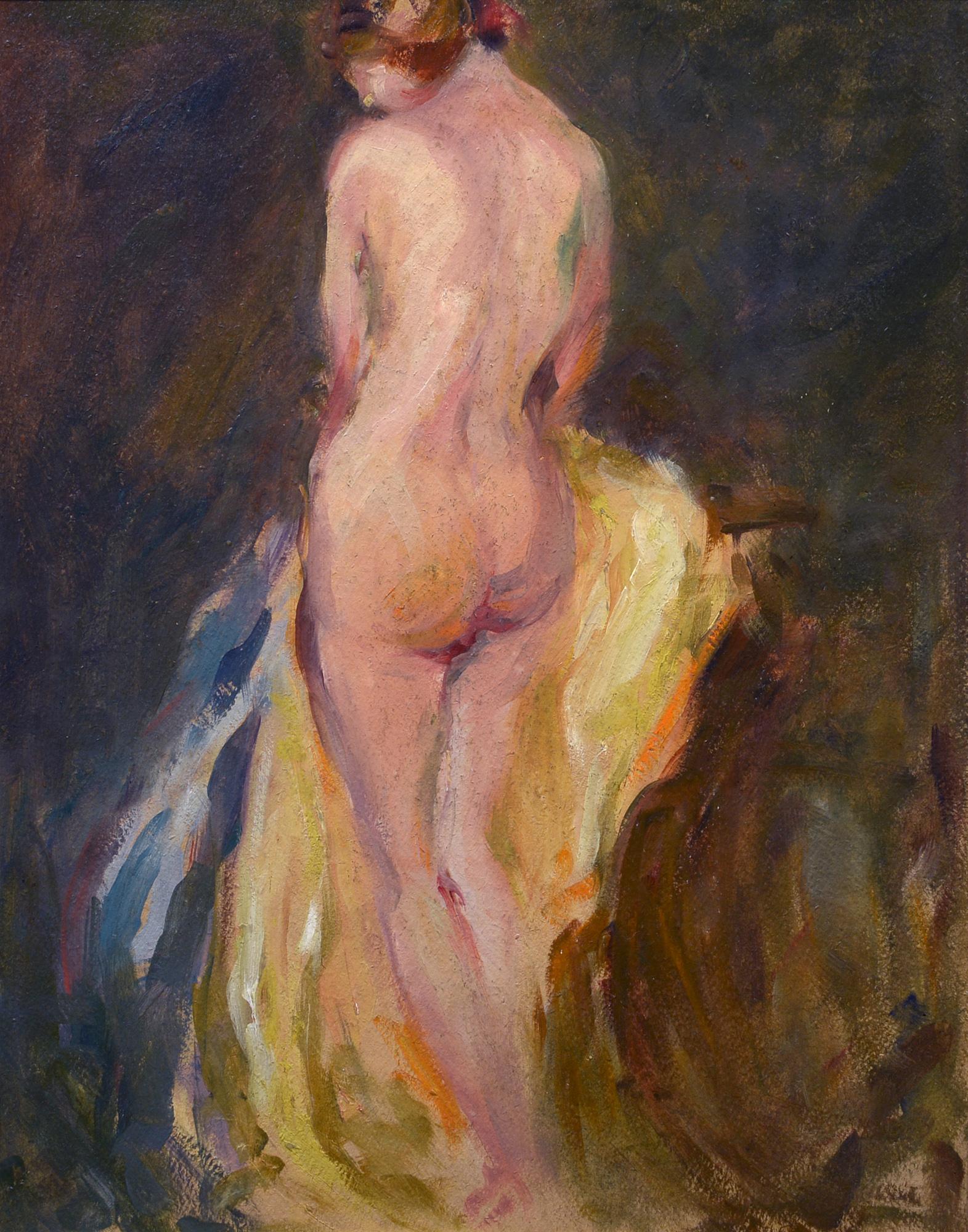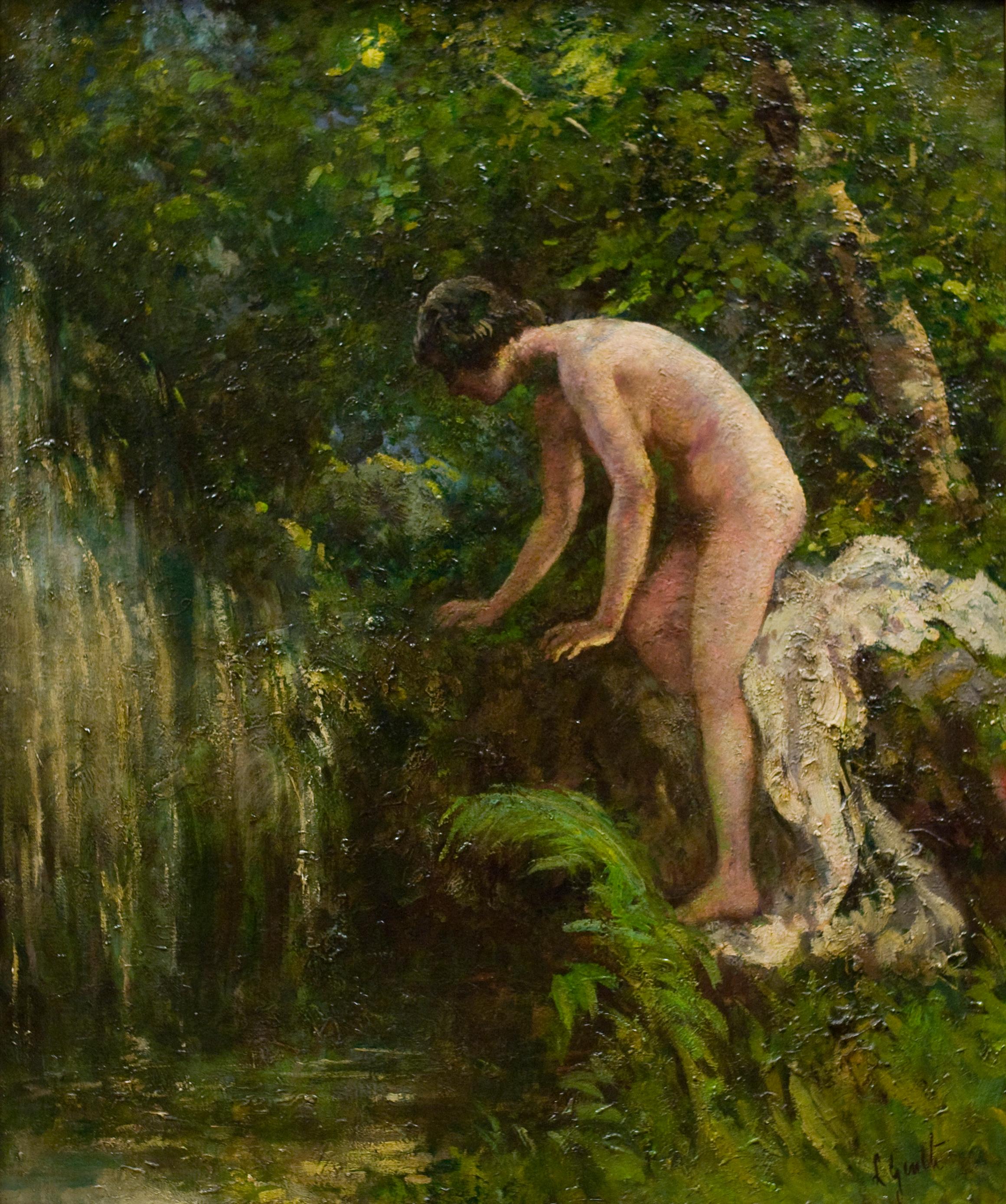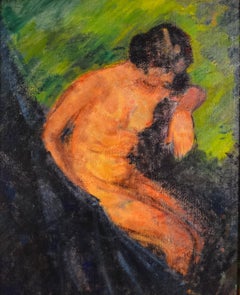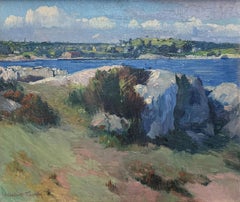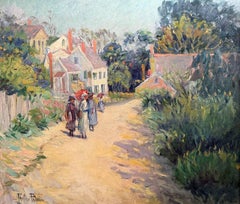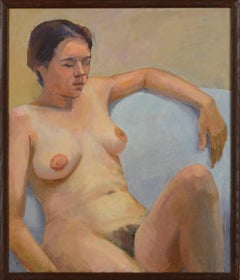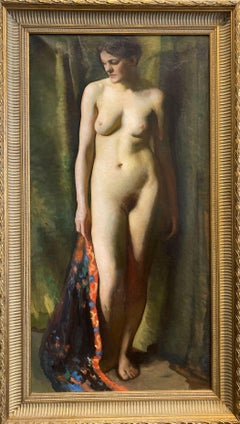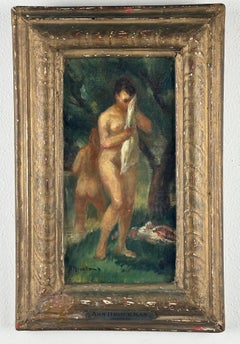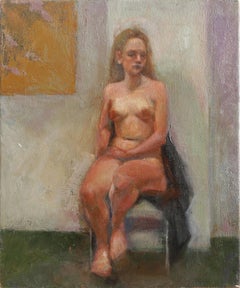Items Similar to "Nude" Marguerite Stuber Pearson, Female Nude, Outdoor Boston School, American
Want more images or videos?
Request additional images or videos from the seller
1 of 11
Marguerite Stuber Pearson"Nude" Marguerite Stuber Pearson, Female Nude, Outdoor Boston School, Americancirca 1940
circa 1940
$4,000
£3,058.21
€3,522.44
CA$5,605.23
A$6,257.71
CHF 3,278.95
MX$76,600.49
NOK 41,642.63
SEK 39,263.72
DKK 26,288.36
About the Item
Marguerite Stuber Pearson
Nude, circa 1940
Signed lower right
Oil on artist board
20 x 16 inches
Marguerite Stuber Pearson was an American painter best known for her elegant portraits, landscapes, still lifes, and interiors. Produced in a loose academic style with a subtle understanding of light and color, she often portrayed quiet moments as seen in this work. Born on August 1, 1899 in Philadelphia, PA, while touring Europe as a teenager Pearson contracted polio resulting in her being a paraplegic the rest of her life. Despite this, she was able to pursue her career without being hindered by artistic development. Pearson studied privately with Aldro Thompson Hibbard, and under Frederick Andrew Bosley at the Boston Museum of Fine Arts School. She worked as an illustrator for magazines and newspapers before dedicating herself to her own career in 1922. The artist died on April 2, 1978 in Rockport, MA. Today, Pearson’s works are held in the collections of the Springville Museum of Art in Utah, the Currier Gallery of Art in Manchester, NH, and the Farhat Art Museum in Beirut, among others.
- Creator:Marguerite Stuber Pearson (1898-1978, American)
- Creation Year:circa 1940
- Dimensions:Height: 26 in (66.04 cm)Width: 20 in (50.8 cm)
- More Editions & Sizes:Unique workPrice: $4,000
- Medium:
- Movement & Style:
- Period:
- Condition:
- Gallery Location:New York, NY
- Reference Number:1stDibs: LU1841216087962
About the Seller
5.0
Platinum Seller
Premium sellers with a 4.7+ rating and 24-hour response times
Established in 2022
1stDibs seller since 2022
115 sales on 1stDibs
Typical response time: <1 hour
- ShippingRetrieving quote...Shipping from: New York, NY
- Return Policy
Authenticity Guarantee
In the unlikely event there’s an issue with an item’s authenticity, contact us within 1 year for a full refund. DetailsMoney-Back Guarantee
If your item is not as described, is damaged in transit, or does not arrive, contact us within 7 days for a full refund. Details24-Hour Cancellation
You have a 24-hour grace period in which to reconsider your purchase, with no questions asked.Vetted Professional Sellers
Our world-class sellers must adhere to strict standards for service and quality, maintaining the integrity of our listings.Price-Match Guarantee
If you find that a seller listed the same item for a lower price elsewhere, we’ll match it.Trusted Global Delivery
Our best-in-class carrier network provides specialized shipping options worldwide, including custom delivery.More From This Seller
View All"Nude, " Arnold Blanch, Woodstock School, WPA, Figurative
By Arnold Blanch
Located in New York, NY
Arnold Blanch
Nude
Signed lower right
Oil on board
20 x 16 inches
Provenance:
G. David Thompson Collection, Pittsburgh
Private Collection, New York
Bo...
Category
1930s Realist Nude Paintings
Materials
Oil, Board
$1,240 Sale Price
50% Off
"Female Nude, " Edith Glackens Dimock, Ashcan School Figurative Painting
By Edith Glackens Dimock
Located in New York, NY
Edith (Glackens) Dimock (1876 - 1955)
Untitled (Female Nude), circa 1915
Oil on canvas
34 1/2 x 28 1/4 inches
Signed lower left
Provenance:
Private Colle...
Category
1910s Ashcan School Nude Paintings
Materials
Canvas, Oil
"Pigeon Hill, Rockport" Winthrop Duthie Turney, North Eastern American Landscape
Located in New York, NY
Winthrop Duthie Turney
Pigeon Hill, Rockport
Signed lower left
Oil on canvas
20 x 24 inches
Exhibited
New York, National Academy of Design, Artists of America, Sixth Annual Exhibition, 1949.
Winthrop Duthie Turney was born in New York City and received his education at the Art Students League. He was affiliated with the Fifteen Gallery...
Category
1920s American Impressionist Figurative Paintings
Materials
Canvas, Oil
"Ladies' Sketch Club" Pauline Palmer, Female American Impressionist Provincetown
By Pauline Palmer
Located in New York, NY
Pauline Palmer
Ladies' Sketch Club
Signed lower left
Oil on board
20 x 24 inches
Pauline Palmer (1867 - 1938) was one of Chicago's early twentieth-century portrait and landscape pa...
Category
1920s American Impressionist Figurative Paintings
Materials
Oil, Board
"Bathing Hour, Belle-en-Mer, France" William Edward Bloomfield Starkweather
By William Edward Bloomfield Starkweather
Located in New York, NY
William Edward Bloomfield Starkweather
Bathing Hour, Belle-en-Mer, France, 1908
Signed lower left
Signed, titled and dated on verso
Oil on canvas
27 x 36 inches
Provenance
Estate of...
Category
Early 1900s American Impressionist Figurative Paintings
Materials
Oil, Canvas
"Summer Landscape, " Joseph DeCamp, Boston Ten American Impressionists
By Joseph Rodefer DeCamp
Located in New York, NY
Joseph Rodefer DeCamp (1858 - 1923)
Summer Landscape
Oil on board
11 x 15 inches
Signed lower right
Born in Cincinnati, Ohio on November 5, 1858, Joseph DeCamp began his artistic career in his teens and remained active throughout his life. Although he initially painted landscapes, Decamp became a renowned and respected portraitist. He was famous for his images of men of high society and women within domestic interiors.
Decamp began his artistic training in 1873 when he enrolled in the McMicken School of Art and Design in Cincinnati. The head of the school, Thomas Satterwhite Noble, was a European-trained painter whose "insistence on rigorous draftsmanship, true to the academic manner in which he had been trained, exerted a lasting influence on DeCamp." DeCamp studied under Noble for five years, but was also a student of Frank Duveneck at the Ohio Mechanics Institute. He adopted Duveneck's bold, realistic style and many of his paintings executed throughout the 1870s and 1880s reflect this influence.
Like most American artists of his generation, DeCamp went abroad to study. In 1878, following in the footsteps of Duveneck and other Midwesterners, he traveled to Munich to attend the Royal Bavarian Academy. Soon after his arrival, however, he gravitated away from the academy and towards Duveneck and eventually followed his mentor to Florence and Venice. During these years, DeCamp focused on landscape and portraiture as his primary subjects. These themes would continue to occupy the artist when he returned to America in 1883.
When DeCamp arrived back in the United States in 1883, he first settled in Cincinnati, but soon moved to Cleveland to teach at what is now Case Western Reserve University. He then relocated once more to the Boston area, where he would remain for most of his life. DeCamp began teaching at Wellesley Female Academy and, in the fall of 1885, began as an instructor at the School of Drawing and Painting at the Museum of Fine Arts in Boston. He quickly established himself as one of the leading figures in the Boston art community and became a founding member of The Ten American Painters, formulated in 1897. This group included Childe Hassam, John Henry Twachtman, Julian Alden Weir, Frank Benson, Thomas Dewing, Willard Metcalf, Robert Reid, Edward Simmons...
Category
19th Century American Impressionist Landscape Paintings
Materials
Oil, Panel
$16,000 Sale Price
20% Off
You May Also Like
Seated Female Nude Figure in Oil on Canvas
By George Wishon
Located in Soquel, CA
Seated Female Nude Figure in Oil on Canvas
Beautiful modern impressionist figure painting of a seated nude woman by George Wishon (American, 1937-2005). The two-toned light blue and...
Category
Late 20th Century American Impressionist Figurative Paintings
Materials
Canvas, Oil
"Large Standing Nude" - Cordelia Brooks, Harvard Class of 1889, Paris Salon
Located in New Orleans, LA
This large and arresting oil on canvas is what I believe must have been one of a pair, with a male nude of exactly the same size and style by the artist that sold at Coletti Gallery ...
Category
1930s Realist Nude Paintings
Materials
Oil
Female Bather (Nude Women)
Located in Wilton Manors, FL
Ann Brockman (1895–1943) was an American artist who achieved success as a figurative painter following a successful career as an illustrator. Born in California, she spent her childhood in the American Far West and, upon marrying the artist William C. McNulty, relocated to Manhattan at the age of 18 in 1914. She took classes at the Art Students League where her teachers included two realist artists of the Ashcan School, George Luks and John Sloan. Her career as an illustrator began in 1919 with cover art for four issues of a fiction monthly called Live Stories. She continued providing cover art and illustrations for popular magazines and books until 1930 when she transitioned from illustrator to professional artist. From that year until her death in 1943, she took part regularly in group and solo exhibitions, receiving a growing amount of critical recognition and praise. In 1939 she told an interviewer that making money as an illustrator was so easy that it "almost spoiled [her] chances of ever being an artist."[1] In reviewing a solo exhibition of her work in 1939, the artist and critic A.Z Kruse wrote: "She paints and composes with a thorough understanding of form and without the slightest hesitancy about anatomical structure. Add to this a magnificent sense of proportion, and impeccable feeling for color and an unmistakable knowledge of what it takes to balance the elements of good pictorial composition and you have a typical Ann Brockman canvas."[2]
Early life and training
Brockman was born in Northern California in 1895 and spent much of her youth in nearby Oregon, Washington, and Utah.[1][3] She met the artist William C. McNulty in Seattle where he was employed as an editorial cartoonist. They married in March 1914 and promptly moved to Manhattan where he worked as a freelance illustrator.[4][5] At the time of their marriage, Brockman was 18 years old.[6] Over the next few years, her career generally followed that path that her husband had previously taken. His art training had been at the Art Students League beginning in 1908; she began her training there after moving to New York in 1914.[1] After an early career as an editorial cartoonist, he freelanced as a magazine and book illustrator beginning in 1914; she began her career as a magazine and book illustrator in 1919.[7] He embarked on a teaching career in the early 1930s and not long after, she began giving art instruction.[8][9] While they both adhered to the realist tradition in art, their usual subjects were different. His prominently depicted urban cityscapes in the social realist whereas hers generally focused on rural landscapes. He was best known for his etchings and she for her oils and watercolors.[8][10]
Brockman returned to the Art Students League in 1926 to take individual instruction for a month at a time from George Luks and John Sloan.[1] Despite their help, one critic said McNulty's "sympathetic encouragement and guidance" was more important to her development as a professional artist.[11]
Career in art
In the course of her career as illustrator, Brockman would sometimes paint portraits of celebrities before drawing them, as for example in 1923 when she painted the French actress Andrée Lafayette who had traveled to New York to play title role in a film called Trilby.[12] She would also sometimes accept commissions to make portrait paintings and in 1929 painted two Scottish terriers on one such commission.[13] During this time, she also produced landscapes. In 1924 she displayed a New England village street scene painting in the Second Annual Exhibition of Paintings, Watercolors, and Drawings in the J. Wanamaker Gallery of Modern Decorative Art.[14] Available sources show no further exhibitions until in 1930 a critic for the Boston Globe described one of her portraits as "well done" in a review of a Rockport Art Association exhibition held that summer.[15]
Between 1931 and her death in 1943, Brockman participated in over thirty group exhibitions and five solos.[note 1] Her paintings appeared in shows of the artists' associations to which she belonged, including the Rockport Art Association, Salons of America, Society of Independent Artists, and National Association of Women Painters and Sculptors.[17][19]Between 1932 and 1935, her paintings appeared frequently in New York's Macbeth Gallery.[20][23][25][27] She won an award for a painting she showed at the Art Institute of Chicago in 1940.[41] In 1942, the Whitney Museum bought one of the paintings she showed in its Biennial of that year.[10] Critical praise for her work steadily increased during the decade that ended with her untimely death in 1943. In 1932, her painting called "The Camera Man" was called "a clever piece of illustration."[21] Three years later, a painting called "Small Town" gave a critic "the impression of freshness, honesty, and skill".[29] In 1938, a critic described her "Folly Cove" as "masterful" and said "Pigeon Hill Picnic" was "sustained by excellence of execution".[48] At that time, Howard Devree of the New York Times saw "evidence of gathering powers" in her work and wrote "she imparts a dramatic feeling to landscape. She even manages this time to do trees touched by Autumn tints without calendar effect, which is no small praise."[51] Three years later, a Times critic reported Brockman had "set herself a new high" in the watercolors she presented,[52] and another critic said the gallery where she was showing had not "for some time" shown "so outstanding a solo exhibitor as Ann Brockman."[2] Shortly before her death, a critic for Art News maintained that she was "one of America's most talented women painters".[46]
After she had died, a critic said Brockman's paintings "displayed real power", adding that she was "highly rated among the nation's professional artists" and was known to give "aid and encouragement, always with a smile," both artists and to her students.[10] in reviewing the memorial exhibition at the Kraushaar Galleries held in 1945, reviewers wrote about the strength and vibrancy of her personality, the quality of her painting ("every bit as good, possibly better than people had thought"),[53] called her "one of the best of our twentieth century women painters", and credited "her sense of the vividness of life" as a contributor to "the unusual breadth that is so characteristic of her work.[11] One noted that her work was "widely recognized throughout the country" and could be found in the collections of prominent museums, including the Metropolitan Museum of Art, the Whitney Museum of American Art, and the Art Institute of Chicago.[54] Writing in the Times, Devree wrote, "even those who had followed the steady growth of this artist for more than a decade, each successive show being at once an evidence of new achievement and an augury of still better work to come, may well be surprised at the combined impact of the selected paintings in the present showing,"[55] and writing in the Brooklyn Daily Eagle, A.Z Kruse said she had made "extraorginary accomplishments", painted with "inordinate distinction" showing a "lyrical majesty," and possessed "a keen esthetic sense which did not deviate from truth."[54]
Artistic style
(1) Ann Brockman, undated drawing, black chalk on paper, 18 x 22 inches
(2) Ann Brockman, High School Picnic, about 1935, oil on canvas, 34 1/4 x 44 1/4 inches
(3) Ann Brockman, untitled landscape, about 1943, watercolor and pencil on paper, 15 1/4 x 22 1/2 inches
(4) Ann Brockman, North Coast, undated watercolor, 21 1/2 x 30 inches
(5) Ann Brockman, On the Beach, 1942, watercolor on paper, 16 1/2 x 20 inches
(6) Ann Brockman, Lot's Wife, 1942, oil on canvas, 46 x 35 inches
(7) Ann Brockman, New York Harbor, 1934, watercolor on paper, 13 1/2 x 19 1/4 inches
(8) Ann Brockman, Youth, 1942, oil on board, 13 1/2 x 11 1/2 inches
Brockman was a figurative painter whose main subjects were rural landscapes and small-town and coastal scenes. She worked in oils and watercolors, becoming better known for the latter late in her career. Most of her paintings were relatively small. Although she made figure pieces infrequently, the nudes and circus and Biblical scenes she painted were seen to be among her best works. In 1938, Howard Devree wrote: "Her gray-day marines and coast scenes are familiar to gallery goers and are favorites with her fellow artists. Her figure pieces have attained a sculptural quality without losing warmth or taking on stiffness. One spirited circus incident of equestriennes about to enter the big tent compares not unfavorably with many of the similar pictures by a long line of painters who have been fascinated by the theme. She imparts a dramatic feeling to landscape. She even manages this time to do trees touched by Autumn tints without calendar effect, which is no small praise."[51] Similarly, a critic for Art Digest wrote that year: "Fluently and virilely painted, [her] canvases suggest a close affinity between nature and humans. The artist takes her subjects out in the open where they may picnic or bathe with space and air about them. A fast tempo is felt in the compositions of restless horses and nimble entertainers busily alert for the coming performance. Miss Brockman is also interested in portraying frightened groups of people, hurrying to safety or standing half-clad in the lowering storm light."[56]
Her palette ranged from vivid colors in bright sunlight to somber ones in the overcast skies of stormy weather. Of the former, one critic spoke of the rich colors and "sun-drenched rocks" of her coastal scenes and another of her "summery landscapes of coves and picnics."[11][50] Of the latter, Howard Devree said she "painted so many moody Maine coast vignettes of lowering skies and uneasy seas that artists have been heard to refer to an effect as 'an Ann Brockman day'".[57]
Brockman's handling of Biblical subjects can be seen in the oil called "Lot's Wife", shown above, Image No. 6. Her watercolor called "On the Beach" and her oil portrait called "Youth" may both indicate the "sculptural quality" that Devree said was typical of her figure pieces (Image No. 8, above).
An example of Brockman's bright palette in a typical summer theme is the oil painting called "High School Picnic" shown above, Image No. 2. Next to it is a painting, an untitled landscape of about 1943 whose medium, watercolor on paper, shows off the sunny palette she often used (Image No. 3).
Among the darkest of her works was an untitled 1942 drawing she made in black chalk (shown above, Image No. 1). In a book called Drawings by American Artists (1947), the artist and art editor Norman Kent noted that this study influenced her painting through its use of "forms" that were "elastic" and suggested "color". He said its "massing of dark and light" created "a definite mood" that was "impressionistic" and had "the strength of a man's work".[58] Brockman's undated watercolor called "North Coast" (shown above, Image No. 4) is an example of the paintings to which Kent referred.
Illustrator
(9) Ann Brockman, cover, March 12, 1917, Every Week magazine
(10) Illustration of an article, "The Taking of a Salient" by Henry Russell...
Category
1930s American Impressionist Nude Paintings
Materials
Oil
$1,200 Sale Price
20% Off
Nude Figure Study II, Impressionist Oil Painting by Lisa Martin
Located in Long Island City, NY
Lisa Martin - Nude Figure Study II, Year: circa 1996, Medium: Oil on Canvas, Size: 18 x 15 in. (45.72 x 38.1 cm)
Category
1990s Impressionist Nude Paintings
Materials
Oil
Spanish Gown, Standing Nude Figure, American Impressionist, 1920s, Oil on Board
Located in Wiscasset, ME
"Spanish Gown" is possibly signed lower right. A painterly American Impressionist work beautifully captures a nude woman stepping from a golden gown. The painting is reminiscent of t...
Category
20th Century American Impressionist Figurative Paintings
Materials
Oil, Board
Nude by a Waterfall
Located in Mc Lean, VA
Signed lower right
Lillian Genth was an important American figurative painter. She studied in the U.S. and in Paris, under James McNeil Whistler. Genth ...
Category
Early 20th Century American Impressionist Figurative Paintings
Materials
Canvas, Oil
More Ways To Browse
Outdoor Vintage Signs
Rockport Oil
Portrait Of Marguerite
Nh Paintings
Vintage Rockport
At Hibbard
Aldro Hibbard Thompson
Andrew Thompson
Pearson Marguerite
Jean Gabriel Domergue
Jean Venetian
Oil Painting Girl With Dog
Olga Painting Acrylic
Peter Max Andy Warhol
Bill Hampton
Cheval Painting
Mark Sargent
Muhammad Ali Painting
